This Is a Good Time to Do Soil Testing and Soil Improvement
Posted on Tuesday, March 22, 2022 · Leave a Comment
This is a good time to beat the rush and get your soil tested so that you can improve your soil before you begin planting.

A simple pH test kit costs under $10 and do fine
Most New England states have soil testing labs available to gardeners. Finding one is as simple as searching for “Soil testing lab near me” in your browser. Your first choice should probably be one run by the state university Extension Service. Most offer a variety of options as to what is tested, and their websites will explain your options, what each costs, and how to collect a sample. Most tests require one or two cups of air-dried soil free of roots and rocks.
Most State labs are very busy in spring, and a 14 to 21 day wait is typical. If you are in a rush to get your soil test results, you might try Logan Labs, a commercial lab in Ohio. They can usually e-mail test results in a few days and also have a soil scientist available to talk to you (for a fee) to make recommendations.
Unless you live where there are natural limestone or marble deposits – parts of Vermont, for example – your soil is probably acidic. Why? Coal fired power plants send sulfur into the air, and it reacts with water to form sulfuric acid that is dropped by the rain. Most plants do best with a soil pH between 6.0 and 6.8. A pH of 7.0 is neutral, and above that is alkaline. Soils rich in organic matter and microorganisms tend to buffer the soil pH, making it less acidic.
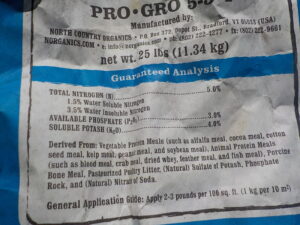
Organic fertilizers generally are slow-release fertilizers
Soils are composed of three things, basically: ground up rock is about 45%, air is about 50% and organic matter about 5%. The particle size of the rock component is what determines soil texture: big particles are in sand, medium particles in silt, and very fine particles make up clay. A good soil has particles of all 3 sizes, but is mostly silt.
You can see what is in your soil by filling a quart jar half full of water, and adding a couple of cups of soil, and then shaking it well. Sand will drop to the bottom pretty much immediately, and silt will drop next. Finally, after 24 hours or so, your clay will form a layer. Each will probably be a different color, and quite obvious. Organic matter often floats on the surface, but generally mixes with the silt layer.
Clay holds onto soil minerals and moisture the best, but it can stay soggy and also get compacted. Sand particles are not electrically charged, so they don’t hold onto minerals like clay or silty soils – but the sand helps with drainage. You can get a feel for your soil by rubbing it between your thumb and a finger after wetting it. Clay soil is sticky. You can feel the grains in a sandy soil.
If your soil has a pH of 6.0 or less, you should add some garden lime or wood ashes to “sweeten it”. If you get a soil test, it should tell you how many pounds of lime to add as expressed in pounds per 100 square feet – a 10 ft. by 10ft. area. I weighed a quart of garden lime in a yogurt container and it weighs a little over 3 pounds. Wood ashes are about equivalent in what they do. But this isn’t rocket science – you don’t have to be precise.
Lime is ground limestone, and is sold in bags at the garden center. It comes as powdered lime or pelletized lime, which is less messy. If you buy powdered lime, wear a mask when spreading it so you don’t inhale it.
All fertilizers add nitrogen (N), phosphorous (P) and potassium (K). The amount of each is expressed as a number that is the percentage of the active ingredient by weight. A 10-10-10 fertilizer has 10 % of each, and 70% filler. The minerals in chemical fertilizers are in the form of salts, and using too much can damage roots. The salts in chemical fertilizer are water soluble and can be dissolved and washed away in heavy rains.
Organic fertilizers, on the other hand, are made from natural ingredients and minerals from ground rocks. My favorite organic fertilizer, Pro-Gro, is made in Vermont and has things such as peanut meal, cotton seed meal, ground oyster shells, feather meal, crab meal, dried blood (for nitrogen) and rock phosphate. I like to compare it to a 7-course meal for plants.

Add fertilizer and compost to hole and stir in before planting scaled
The ingredients of an organic fertilizer mostly need to be digested by microorganisms found in the soil, and then shared with green plants. They are gentler, and slow to release their goodies. The mineral content of Pro-Gro is listed as 5-3-4, which is lower than most chemical fertilizer, but offers all those micronutrients not found in chemical fertilizers.
Of course you can go the old fashioned way and add animal manures to improve your soil. They work, but some may also introduce weed seeds. I don’t recommend using fresh horse or cow manure because of that, but manure that is a year or two old has fewer seeds. Rabbit, sheep and goat manure has fewer weed seeds, and they add plenty of organic matter that helps with texture and tilth.
If you add compost to your garden and work it in, it will become more biologically active – full of beneficial microorganisms. It will drain much better, but hold moisture better, too.
Having good soil is one of the keys to being a good gardener. Perhaps testing and improving your soil will help you to have that elusive green thumb. It’s worth trying.
How to Improve Your Soil
Posted on Tuesday, April 28, 2020 · Leave a Comment
As we move from dreaming to planting, we all want to offer our plants the perfect soil. This leads some gardeners to buy a big bag of 10-10-10 and sprinkle it heavily on everything. For others, manure or compost is the answer to increasing soil productivity and plant health. And then there are bagged minerals, organic bagged fertilizers, rock powders and more.
What do plants need? Scientists agree that plants need minerals for health: nitrogen (N) for promoting green growth; phosphorous (P) for better roots and promoting flowers, seeds and fruits; potassium (K) for strong cell walls to survive drought and cold. These three elements are often called “the big three” and listed as percentage by weight on fertilizer bags (5-10-5, for example). Chemical fertilizers have just those three elements, plus inert fillers (which would be 80% in the example cited).
Additionally, there are elements that are needed in smaller amounts including magnesium, calcium and sulfur. In very small amounts plants need iron, chlorine, manganese, zinc, copper, boron, molybdenum and nickel. None of those are found in chemical fertilizers, but are present in unlisted amounts in bagged organic fertilizers, and in good compost.
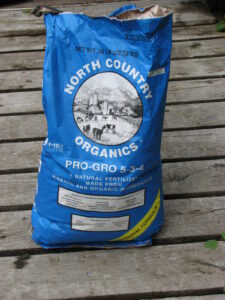
Organic fertilizers contain more healthy minerals than chemical fertilizers 002
Bagged organic fertilizers are made from natural ingredients, things like ground oyster shells and seaweed, or dehydrated chicken manure, or cotton seed meal and peanut hulls. Added to the mix are minerals such as rock phosphate (a good source of slow-release phosphorus) and green sand (a source of potassium from the sea).
These are slow release fertilizers. Most of the ingredients are not water soluble, but are broken down and utilized in concert with bacteria and fungi in the soil. That is good, as they are not washed away in rainy times the way many chemical fertilizers are.
Here in the Northeast most soils are a bit acidic due to acid rain, so adding limestone is good for getting your soil near neutral. But not all plants need the same things in the soil. Blueberries, for example, need very acidic soil. Instead of lime, they may need sulfur to make the soil more acidic.
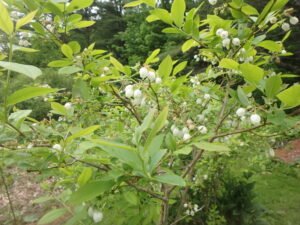
Lots of blueberry blossoms tell me the soil is acidic enough
A simple soil pH test kit can be purchased for under $10, or you can send a sample to your state Extension Service for testing, Go online and search for soil tests in your state, and you will find how to collect the soil, and where to send it. A basic soil test will tell you much in addition to the soil pH.
I’ve been adding finely ground granite dust to my soil for 20 years or so, and a commercially prepared rock and mineral soil supplement called Azomite for nearly as long. I’ve done side-by-side trials of plants with rock powders and without them, and have seen dramatic differences. Soils with rock powders have helped plants survive drought, and have increased crop yield in my peppers.
The mechanism by which rock powders work is unknown. I interviewed a soil scientist who pointed out that every 10,000 years or so we’ve had glaciers come down and deposit ground rock, distributing obscure minerals in the soil. Maybe the rock powders I add are just mimicking what the glaciers have done – though not recently.
What about compost? It is pure gold, from a soil perspective. It has all the minerals needed by plants and good compost also has literally millions of beneficial bacteria, fungi and other living things in each spoon of goodness.
Beneficial organisms in compost work with your plants, sharing minerals with your plants; they benefit from sugars exuded from the roots each night. That’s right, over eons the plants and microorganisms have developed a mutually beneficial system.
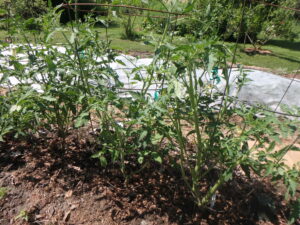
Tomatoes benefit from a little slow release fertilizer at planting time
I should explain that compost is not high in nitrogen. But most vegetables and annual flowers don’t need a lot of nitrogen. Nitrogen will make veggies like peppers or tomatoes grow big plants, but often those big plants do not produce a lot of fruit. Most annual flowers do not need much nitrogen.
How much compost should you use? I have been putting an inch or two over my vegetable beds every year, and working it in. If you are buying it by the bag, even half an inch is good – with some extra in the hole with each tomato.
What about trees and shrubs? Most do not need fertilizer or those tree fertilizer spikes sold at hardware stores. Mother Nature does not provide fertilizer, she adds organic matter to the soil over time as leaves decompose and living beings of all sorts die and add to the soil.
That said, if you live in a new subdivision, your soil may be nothing but sterile subsoil with a thin layer of “topsoil” spread by the contractor. Adding organic matter to the soil in the form of compost will help it become biologically active. It will add minuscule amounts of the less common minerals.
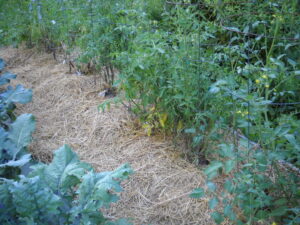
Hay and straw make good mulches
Mulch all your beds with ground leaves, grass clippings, mulch hay or straw. These will break down with time, and add organic matter to the soil. Breakdown of that mulch is done by bacteria and fungi.
Treat your soil to some compost at planting time. And if you use fertilizer, don’t overdo it – more is not better. Read the directions of anything you add to the soil.
Henry Homeyer can be reached at
henry.homeyer@comcast.net. He is a long time UNH Master Gardener and the author of 4 gardening books.









